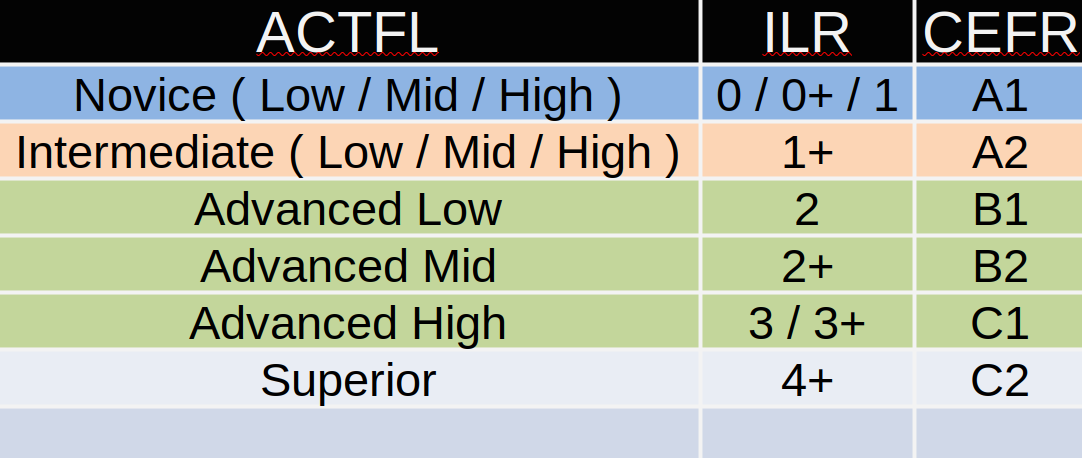In business communication, both internal and external, the goal is to reach and engage the target audience. One way to do this is to write while referencing reading proficiency standards. Reading proficiency standards are guidelines that measure an individual’s ability to comprehend written material. These standards take into account factors such as vocabulary, sentence structure, and overall text complexity. By understanding the reading level of the target audience, authors tailor content to ensure the message is clear, concise, and easily understood.
There are three standards that are used primarily in the United Stated and Europe. The ILR, or Interagency Language Roundtable, is a standard developed and in use by the US federal government. The American Council on the Teaching of Foreign Languages, or ACTFL, is a guideline that targets the reading proficiency of English language learners from Novice to Superior. The ILR and ACTFL standards are aligned pretty closely with each other. The third standard, the CEFR, or Common European Framework or Reference for Languages, describes the proficiency of learners of European languages.
Writing to a level that matches the audience’s reading abilities increases the likelihood that the content will be fully understood, leading to better information retention and more effective communication. Content that is easy to read and digest is more engaging for the reader. By meeting the reader’s level of proficiency, their attention is captured and maintained, hopefully making them more receptive to the key points of the content. Writing to appropriate reading levels makes content accessible to a wider range of readers, including those with varying educational backgrounds or language comprehension abilities.
Writers develop credibility with readers by demonstrating the ability to communicate complex topics simply and clearly. Writers can avoid overly complex vocabulary, lengthy sentences, and convoluted sentence structures and instead opt for clear, concise language that is easy to understand. Content creators can also incorporate visual elements: enhancing written content with visual aids, such as infographics, charts, or diagrams helps convey information in a more accessible and engaging manner.

The ILR and ACTFL are closely aligned, with clear correspondences between their levels.
Aligning CEFR to the other two frameworks is a bit more complex, as CEFR was developed independently. While research has shown ways to map CEFR to ACTFL, there are no official, recognized alignments. The ILR scale structure has 6 main levels (0-5) with nuanced “+” levels in between while CEFR with 6 main levels (A1-C2). The ACTFL has 4 main levels (Novice, Intermediate, Advanced, Superior) with “low”, “mid”, and “high” sub-levels.
The ILR, CEFR, and ACTFL reading proficiency standards differ in proficiency definitions and scope:
Proficiency Descriptions:
- ILR focuses on functional language abilities across different skills.
- ACTFL provides detailed guidelines on the specific communication tasks and abilities associated with each proficiency level.
- CEFR describes language proficiency in terms of what a user can do with the language.
Scope and Purpose:
- ILR was developed for U.S. government language needs.
- ACTFL was developed in the U.S. to support language learners from non-English speaking backgrounds.
- CEFR was developed in Europe to provide a common framework for language education.
In addition to these three standards, there are other methods by which reading proficiency levels are often determined:
Cloze Tests: The Cloze test is a technique in which every fifth word is deleted from a passage, and readers must fill in the blanks with words that make sense. The percentage of correct responses determines the reader’s proficiency level – 0-30% is “frustration” level, 31-49% is “instructional” level, and 50-100% is “independent” level.
Readability Formulas: The Flesch-Kincaid Grade Level test analyzes factors such as word and sentence length to determine the reading grade level of a text. This analysis provides insight into the technical reading skills required to comprehend the material.
Observational Studies: Researchers have conducted studies observing the reading tasks and skills used by office workers, identifying key skills like proofreading, verifying, and comprehending detail.
Sources:
“What are the Different Levels of Reading Proficiency?”; Learn languages Fast blog; Cate Deans; https://www.learnlanguagesfast.com/talking-about-language-learning/what-are-different-levels-language-proficiency/
“Proficiency Scales”; Language Testing International Blog; https://www.languagetesting.com/proficiency-scales
